
Improving Irrigation Efficiency and Annual Water Use Reporting
DOWNLOADJuly 8, 2024 - Michigan State University Extension
Impacts
- 41 irrigation presentations were given.
- 2,728 farmers, agricultural professionals and policymakers participated in field days.
- 178 work groups and farms were visited to support 1,316 farmers and agricultural professionals.
Agricultural irrigation accounted for 39% of Michigan’s consumptive water use (Michigan Department of Environmental Quality, 2017), with 125 billion gallons of water withdrawn in 2020 (Eaton, 2021). Energy consumption of center pivot systems, which accounts for approximately 90% of Michigan’s irrigation (U.S. Department of Agriculture, 2018), is estimated at 4% of Michigan’s total energy consumption (Michigan Department of Environment, Great Lakes, and Energy, 2022). Since over 90% of the energy for irrigation is used for pumping water, energy efficiency is tied tightly to water use efficiency (Ciolkosz & Go, 2022). The two greatest factors affecting irrigation efficiency are irrigation system uniformity and proper scheduling of irrigation applications. Michigan State University (MSU) Extension used a variety of methods to educate irrigators and policymakers in 2023, including in-person and recorded presentations, articles, websites and field demonstrations.
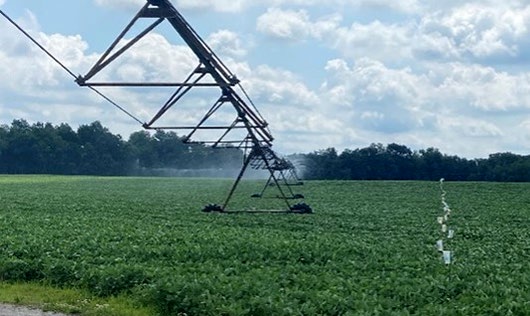
Priority Areas
Irrigation plays an important role in Michigan agriculture, supporting various crops such as corn, soybean, potato, fruits, vegetables and orchards. High-value crops including potatoes, vegetables, fruits and seed crops are nearly 100% produced under irrigation and require an irrigation system upon contract. Only 7% of Michigan’s farmland is irrigated, but this irrigated land accounts for over 40% of the state’s cropland income (Michigan Farm Bureau, 2023).
For additional information regarding irrigation educational programs and materials, contact:
Lyndon Kelley, MSU Extension/Purdue Extension irrigation specialist, at 269- 467-5511 or kelleyl@msu.edu.
Younsuk Dong, MSU Biosystems and Agricultural Engineering assistant professor and irrigation specialist, at 517-432-8751 or dongyoun@msu.edu.
Irrigation Educational Presentations and Outreach
In 2023, staff from the MSU Department of Biosystems and Agricultural Engineering and MSU Extension developed and delivered 41 presentations focused on improving irrigation system uniformity and irrigation scheduling. These presentations were given at field days hosted by MSU Extension, commodity groups, other state agencies and irrigation equipment suppliers. More than 2,728 farmers, agricultural professionals and policymakers participated. Farm papers, agriculture-focused magazines and newsletters published two MSU Extension articles addressing irrigation system uniformity and proper scheduling. The MSU Biosystems and Agricultural Engineering Irrigation website had 551 visits, 1,001 pageviews, 807 unique pageviews and 150 downloaded Extension bulletins and irrigation scheduling tools in 2023.
Catering to those producers and irrigation enthusiasts desiring a webinar and recorded irrigation information, MSU Extension and the MSU Department of Biosystems and Agricultural Engineering coordinated a Water Management Day each of the last two winters. Younsuk Dong, MSU assistant professor and irrigation specialist, has presented several aspects of increasing irrigation efficiency. MSU irrigation and field crop educators have filled out the five hours of the recorded program. The recorded presentations serve as a library of recordings on various water management topics that can be accessed throughout the year.
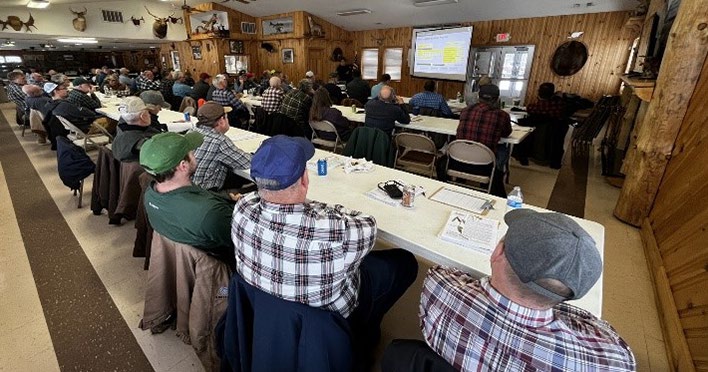
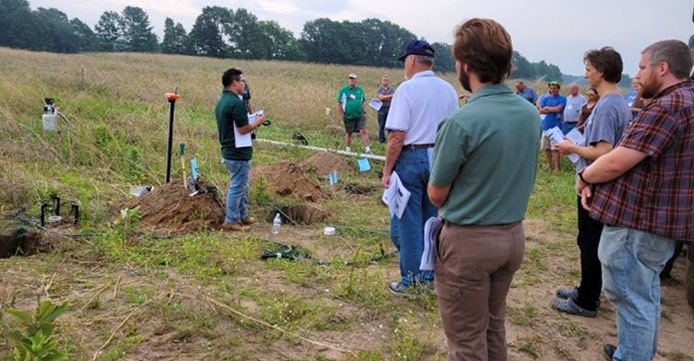
Using Field Demonstrations to Improve Irrigation Efficiency
Two field demonstrations documented the improvements that could be made to typical irrigation systems with an upgrade of the sprinkler package. Center pivot irrigation systems were evaluated and retrofitted with the support of MSU Project GREEEN (Generating Research and Extension to meet Economic and Environmental Needs). The team has found that the coefficient for uniformity was increased by 20%, resulting in water savings of 1.2 inches to 3.3 inches per acre in a typical season. This is equivalent to 3 million to 9 million gallons of water saved and $420 to $1,617 of energy savings for a hundred-acre irrigated field each year. In 2017, there were 617,826 irrigated corn, soybean and potato fields in Michigan (U.S. Department of Agriculture, 2018). This potentially could save 20 billion to 55 billion gallons of water annually, contributing to 16% to 44% of the total water withdrawals used for irrigation.
The MSU irrigation team has collaborated with the Michigan Soybean Committee, the Michigan Potato Industry Commission, the Michigan Blueberry Commission, the Michigan Tree Fruit Commission, the Michigan Asparagus Advisory Board, the Michigan Christmas Tree Association and the Michigan State Horticultural Society to conduct irrigation research at 17 Michigan farms and four MSU AgBioResearch centers in 2023. Most of the irrigation projects focus on improving irrigation water use efficiency using irrigation scheduling methods and sensor technology. The team has found that an automated smart irrigation system, which was based on soil moisture sensors in a tomato field, has shown an improvement in irrigation water use efficiency by 40%. In addition, a 2023 U.S. Department of Agriculture Natural Resources Conservation Service (NRCS)–supported irrigation demonstration study conducted by the MSU Irrigation Lab found that the smart irrigation sensor technology helped to save 1.9 inches of applied irrigation water in a commercial corn field and 2 inches of water application in a soybean field, while maintaining the same yield and/ or higher yield as the farmer’s existing irrigation strategies (crop condition and soil feel testing). In 2018, irrigated corn and soybean acres in Michigan were 378,664 and 192,450 acres, respectively (U.S. Department of Agriculture, 2018). Therefore, up to 29 billion gallons of freshwater, representing about 23% of Michigan’s total agricultural water use (125 billion gallons in 2020) from irrigated corn and soybean fields, could be conserved by using smart irrigation sensor technology.

Michiana Irrigated Corn and Soybean Conference
The Michiana Irrigated Corn and Soybean Workshop is a long-standing collaboration between MSU and Purdue Extension focused on irrigators in southern Michigan and northern Indiana. Historically held at the Blue Gate Theatre in Shipshewana, Indiana, in late winter, this meeting typically draws roughly half of attendees from each state. In 2023, 53 attendees were from Indiana and 68 were from Michigan.
Speakers from across the Midwest address topics specific to irrigated row crop farmers. In 2023, Daran Rudnick from the University of Nebraska–Lincoln discussed the economics of irrigation in person and Greg Tylka from Iowa State University talked about soybean cyst nematode via Zoom. Other speakers included Extension faculty and educators from both MSU and Purdue. The cost of the event to attendees is kept low due to the continued generous support from the corn and soybean checkoff programs of Indiana and Michigan.

Each year, a post-meeting survey is given to measure the impact of the education provided. Of the 78 people who returned the survey, 92% indicated their knowledge increased and 69% planned to change some aspect of their farm operation or recommendations to producers as a result of the information presented. These changes were estimated to impact 48,984 acres and result in $707,184 in increased revenue or savings.
A 10-month follow-up survey was also sent to participants to see what changes were actually made during the growing season due to information provided at the meeting. Of the 21 surveys returned, 13 respondents (62%) indicated they had changed some aspects of their operation or recommendations to producers during the growing season. These changes were estimated to impact 15,292 acres and result in $116,623 in increased revenue or savings, or $8,971 per farm.
Re-Classification of Watersheds and the Impact on Large Volume Water Withdrawal Registrations Available
Since its inception in 2006 and modification in 2008, Michigan has relied upon the Michigan Water Withdrawal Assessment Tool (MIWWAT) to set limitations on available water for agriculture and other Large Volume Water Uses (LVWU). In 2021 the Michigan Water Use Advisory Council enacted provisions to change the fish classifications of the stream within a watershed resetting the available large volume water that may be used.
The classifications within the LVWU registration system are based on the characteristic fish population and establish the percentage of a stream’s base flow that can be allocated for use. A stream’s base flow is the average flow in its lowest month. This coefficient ranges from 24% for large warm rivers down to 4% for cold transitional streams. Changes in the stream classification can make a huge change in available water for large volume water use within that watershed.
The Prairie River watershed within Branch County, Michigan, was the first of the watershed classification changes to be proposed. Originally, the Prairie River was deemed a small warm river and allowed a fairly high allocation of water. The proposed change would move that allocation down dramatically, making new registrations for large volume water use nearly impossible. Current registrations under this proposed change would be beyond limitation within MIWWAT, like an overdraft of a checking account.
Many large volume water users across the state have been watching the re-classification discussion in the Prairie River and are concerned with how these re-classifications may result in a moratorium on new agricultural water uses and additional scrutiny on existing registered users. Concerned producers from the Upper Peninsula to the Indiana state line have formed work groups to work with legislators or started gathering stream flow data and impact studies to prepare for changes in their areas.
Three Michigan counties and four townships received information on the potential impact of the re-classification of the Prairie River within MIWWAT. This resulted in roundtable discussions and work sessions between commissioners, Michigan Department of Natural Resources Fishery Division, and Michigan Department of Environment, Great Lakes, and Energy staff that MSU Extension staff helped coordinate.
Two LVWU user groups within the area held several meetings with irrigators and livestock producers to discuss the potential impact on agriculture. MSU Extension personnel assisted with coordination and provided technical resources. MSU Extension–sponsored educational programs provide nine opportunities for state agencies and LVWU users group leaders to present information on the topic to water users and associated agri-businesses in the state.
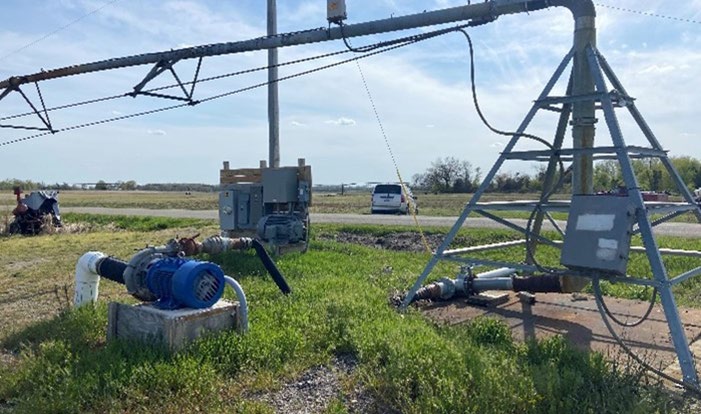
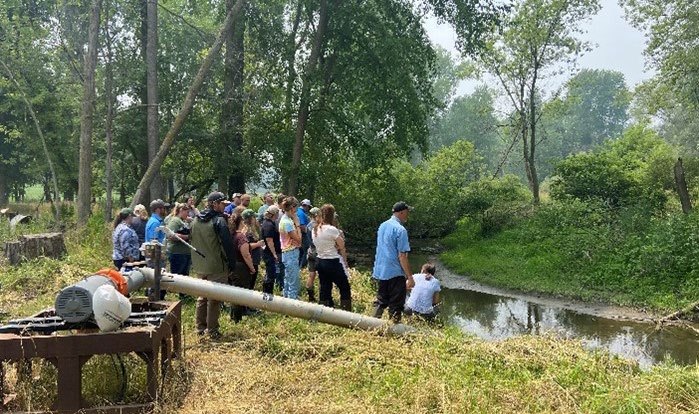
References
Ciolkosz, D., & Go, A., (2022). Energy use on the farm. In D. Ciolkosz (Ed.), Regional perspectives on farm energy. Springer. https://link.springer.com/chapter/10.1007/978-3-030-90831-7_1
Eaton, A., (2022). MAEAP water use reporting. (MDARD Annual Report 2022). https://www.michigan.gov/mdard/-/media/Project/Websites/mdard/documents/environment/maeap/2022-maeap-water-use-reporting-annual-report.?rev=406aafec47c54de9b3d3fa7eea800e04&hash=4016F6CB2E918414C66C0AC69CDB4D35
Michigan Department of Environment, Great Lakes, and Energy. (2022). Water Use Advisory Council report. https://www.michigan.gov/egle/-/media/Project/Websites/egle/Documents/Groups/WUAC/Report-2022-WUAC.pdf?rev=f2d4d73fe62c4ebb826bf6a9ddf8a8d5
Michigan Department of Environmental Quality. (2017). Water use statistics. https://www.michigan.gov/-/media/Project/Websites/egle/Documents/Multi-Division/Water-Use-Statistics.pdf?rev=4a29b80e499549c294bbdf0044b507fa
Michigan Farm Bureau. (2023). Act now to protect water use for food production. Michigan Farm News. https://www.michiganfarmnews.com/act-now-to-protect-water-use-for-food-production
U.S. Department of Agriculture. (2018). Irrigated Farms by Acres Irrigated in 2018. 2018 Irrigation and Water Management Survey. USDA National Statistics Service.



 Print
Print Email
Email



